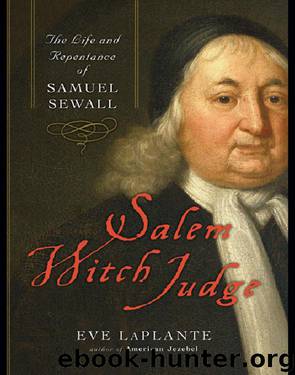Salem Witch Judge by Eve LaPlante

Author:Eve LaPlante
Language: eng
Format: epub
ISBN: 9780061753473
Publisher: HarperCollins
The next day Stephen and his wife arrived in Boston to stay with Samuel and his family. Stephen likely carried the transcripts with him. On September 22 Cotton Mather called at Samuel’s house, where Mather, Judge Stoughton, Judge Hathorne, and the Sewall brothers jointly discussed whether and in what form to publish “some trials of the witches.” Stoughton departed the gathering early but returned because “it began to rain and was very dark.” Samuel offered him a room for the night, which the chief justice accepted, but “he went away early in the morn.” Before Samuel fell asleep that night he studied John 1: “In the beginning was the Word, and the Word was with God, and the Word was God.”
In Salem on September 22, three days after the death of her husband, Martha Corey and six other women and one man were hanged. Samuel, who was not present, was told that Goodwife Corey walked to the gallows in prayer. The other people who were killed that day, most of whom he and his colleagues had convicted in September, were a fisherman’s wife from Salem named Alice Parker; Samuel Wardwell, an Andover farmer; Ann Pudeator, of Salem Village; Margaret Scott, of Rowley; an Andover widow, Mary Parker; a Marblehead woman named Wilmot Reed; and Mary Esty, a mother of seven in her late fifties from Topsfield.
Esty’s older sister Rebecca Nurse had preceded her to the gallows, and her younger sister Sarah Cloyse was still in jail, convicted and condemned. “I know not the least thing of witchcraft,” Mary Esty had told Samuel and the other judges during her examination. They condemned her to death. She wrote to them from jail. “I would humbly beg of you, that Your Honors would be pleased to examine these afflicted persons strictly, and keep them apart some time, and likewise to try some of these confessing witches….” If the court tried the confessed witches, many of whom were accusers, then there would be no incentive to make false confessions. Similarly, the testimony of the accusers would not hold up if they testified separately and without the accused being present. If the court adopted these practices, she added, “I question not but you will see an alteration of these things.”
After these executions, which would turn out to be America’s final executions for witchcraft, the Reverend Nicholas Noyes studied the eight bodies hanging from ropes. Loud enough for the crowd to hear him, Samuel’s old friend remarked, “What a sad thing it is to see eight firebrands of hell hanging there.”
Download
This site does not store any files on its server. We only index and link to content provided by other sites. Please contact the content providers to delete copyright contents if any and email us, we'll remove relevant links or contents immediately.
The Gnostic Gospels by Pagels Elaine(2400)
Jesus by Paul Johnson(2230)
Devil, The by Almond Philip C(2207)
The Nativity by Geza Vermes(2117)
The Psychedelic Gospels: The Secret History of Hallucinogens in Christianity by Jerry B. Brown(2073)
Forensics by Val McDermid(1979)
Going Clear: Scientology, Hollywood, and the Prison of Belief by Lawrence Wright(1884)
Going Clear by Lawrence Wright(1873)
Barking to the Choir by Gregory Boyle(1731)
Old Testament History by John H. Sailhamer(1714)
Augustine: Conversions to Confessions by Robin Lane Fox(1688)
The Early Centuries - Byzantium 01 by John Julius Norwich(1655)
A History of the Franks by Gregory of Tours(1639)
The Bible Doesn't Say That by Dr. Joel M. Hoffman(1611)
Dark Mysteries of the Vatican by H. Paul Jeffers(1607)
A Prophet with Honor by William C. Martin(1603)
by Christianity & Islam(1564)
The First Crusade by Thomas Asbridge(1539)
The Amish by Steven M. Nolt(1492)
